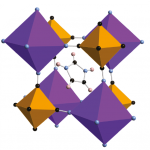We have a longstanding interest in the family of Prussian blue analogues: metal ions bridged by cyanide linkers into a cubic framework that can accommodate many different guests in the pores. In a paper just published in CrystEngComm, arising from Helen Duncan’s PhD work, we use total neutron scattering measurements at ISIS to investigate one of these materials that contains planar imidazolium ions in the interstices.1
Our target material, potassium imidazolium hexacyanoferrate, (C3N2H5)2K[Fe(CN)6], has three phases as a function of temperature at ambient pressure: the imidazolium cations are free to rotate in the intermediate- and high-temperature phases, but freeze into fixed orientations in the low-temperature phase. The phase transition between intermediate- and low-temperature phases thus causes a substantial change in this material’s dielectric constant. However, the details of the cation motion, and in particular how this is different between intermediate- and high-temperature phases, remain unclear.
In this paper, we use reverse Monte Carlo modelling to show that the intermediate-temperature phase is associated with a stiffening of the metal-cyanide framework compared to either of the other phases. This shows that the dynamics responsible for the phase transitions involve competition between the energetic penalty for bending the metal-cyanide links and the benefit of host–guest hydrogen bonding. The key results are that disordered framework materials have important local structure that is not visible to Bragg scattering, and that there is a crucial link between this structure and the dynamics that give rise to exploitable electric properties.
